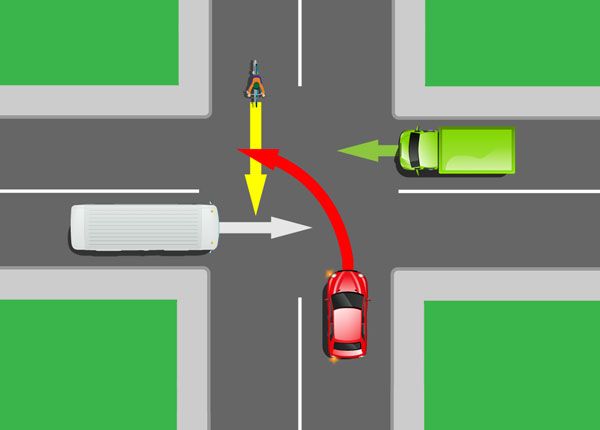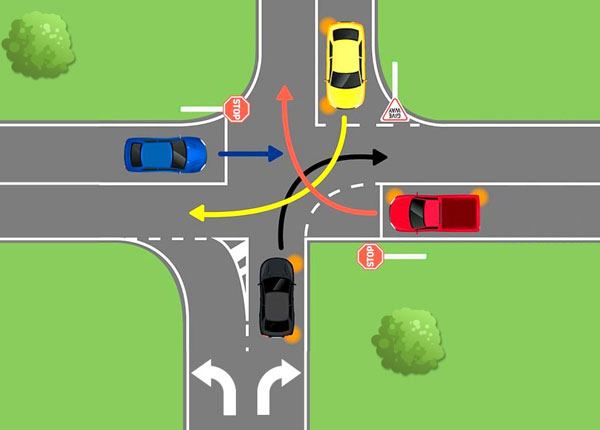
Right of Way Rules for Every Occasion: Who Goes First on the Road?
Updated Oct. 12, 2020Right-of-way is perhaps the most important concept you will study as a new driver. When a driver has right-of-way, it means they currently have permission to pass over a section of roadway. The rules governing right-of-way will come into play in dozens of different driving situations, on practically every journey you make. Whenever two motorists wish to occupy the same section of roadway at the same time, right-of-way rules will determine who goes first. Understanding and respecting right-of-way is essential, as it allows road users to avoid conflicts that could impede traffic flow or cause a collision.
- Right-of-way definition
- Right-of-way must be given
- Yield when in doubt
- Right-of-way avoidance
- Right-of-way for special road users
- Right-of-way at intersections
- Right-of-way at roundabouts
- The importance of pedestrian right-of-way
- Right-of-way on hills and mountain roads
- Right-of-way for school buses
- Right-of-way for emergency vehicles
- Right-of-way at railroad crossings
Right-of-way definition
With specific reference to traffic laws, the Encyclopedia of American Law states that right-of-way “refers to a preference of one of two vehicles or vessels, or between a motor vehicle and a pedestrian, asserting the right of passage at the same place and time”.
To put it simply, right-of-way laws apply whenever two or more vehicles (or vehicles and pedestrians) need to pass over the same space. They will dictate the order in which traffic moves at intersections, pedestrian crosswalks, railroad crossings and whenever a motorist wishes to merge into a new lane of traffic. Many motorists misunderstand right-of-way in that they assume it is automatic. In fact, you only ever have right-of-way if that right is yielded to you by another road user.
Right-of-way must be given
All motorists must understand that the law does not automatically award them right-of-way, even in situations where the right-of-way should be theirs. To have the lawful right-of-way in any driving situation, another road user must give up or “yield” it to you. Right-of-way laws simply state when a vehicle or pedestrian must yield.
If another motorist fails to yield the right-of-way to you when they should, they are breaking the law. However, if you forcibly claim the right-of-way from a motorist who has failed to yield, you are breaking the law too.
Yield when in doubt
Legally, every road user must do everything in their power to avoid a crash. If you assert right-of-way over another road user without it being freely given, you are increasing the likelihood that a collision will occur. NEVER take right-of-way if doing so would put you or another road user in a less safe situation.
Whenever another driver insists on claiming the right-of-way, you must yield – irrespective of who is right. The National Highway Traffic Safety Administration reports that “failure to yield right-of-way” was a major contributing factor in 3,659 fatal crashes in 2016. If death, injury or property damage occur as a result of you failing to yield the right-of-way, you will be held legally accountable. This is true even if the law states that the other motorist should have yielded the right-of-way.
It can be extremely frustrating when another driver fails to yield as they should. However, it is important to remember not to react or attempt to reprimand the other motorist in these situations. It is not your job to enforce the law. If the driver in question repeatedly disregards right-of-way rules, they will eventually be caught and cited or prosecuted for it. Trust that justice will be done.
Right-of-way avoidance
Right-of-way rules apply on all public roads, though they do not necessarily apply on private property. However, this does not mean that you can drive through or over private property to avoid obeying right-of-way law! Irresponsible drivers occasionally try this tactic thinking they are being clever – don’t go there. In doing so, you would be breaking a different set of laws and could even end up being arrested for trespassing.
Right-of-way for special road users
Right-of-way rules do not only dictate who goes first when two or more vehicles seek to drive over the same portion of road at the same time. There are also special right-of-way rules referring to certain types of road user, which may or may not apply in different situations. These rules generally serve to protect vulnerable or high-priority road users, such as pedestrians, cyclists, emergency vehicles and school buses.
Right-of-way at intersections
This block begins our exploration of right-of-way rules with a look at how they apply at intersections. At any point where different streets intersect, two or more vehicles may be seeking to use the same portion of roadway simultaneously. Which vehicle goes first may be dictated exclusively by right-of-way rules or it may be determined by a combination of traffic control devices and right-of-way rules.
The key thing to remember is that right-of-way rules will ALWAYS apply to some degree. Plus, you must be prepared to yield at an intersection, even if a green traffic light indicates that the right-of-way should be yours. Unfortunately, traffic signals are sometimes disobeyed through negligence or deliberate misconduct. If another driver fails to yield the right-of-way when a red traffic light indicates that they should, you must yield to avoid an accident.
Right-of-way at roundabouts
This special type of intersection is addressed during a dedicated article, later in this section. Roundabouts are a little different to standard intersections, as they are designed to minimize path-of-travel conflicts by channeling all traffic in the same direction around a circular island. When right-of-way rules are obeyed, roundabouts are incredibly safe.
Traffic laws state that vehicles already circling a roundabout should have right-of-way over vehicles seeking to enter the roundabout, which means all drivers approaching the intersection must yield. Pedestrians may cross the road at roundabouts just as they would at any other intersection. Drivers must always yield to pedestrians occupying or seeking to use a crosswalk upon entering and leaving a roundabout.
The importance of pedestrian right-of-way
Motorists must yield the right-of-way to pedestrians at crosswalks and on the sidewalk. In fact, you should ALWAYS yield to a pedestrian if physically possible, even if they are occupying a space you wish to drive on and the right-of-way should be yours. Collisions between vehicles and pedestrians nearly always result in injury or death for the pedestrian. When pedestrians are nearby, motorists must remain vigilant and drive with caution. Learn how and when you must yield the right-of-way to the highway transportation system’s most vulnerable road users, in “Right-of-Way for Pedestrians”.
Always yield at pedestrian crosswalks
Unless a pedestrian crosswalk is controlled by traffic lights, drivers must yield to any pedestrian waiting at the crosswalk’s edge to cross the road. Whenever a pedestrian is using the crosswalk, you must stop and wait for them to completely clear the roadway before proceeding, even if a green light indicates that you may go. Remember that many pedestrians do not obey proper right-of-way rules and may dart out into a crosswalk when a “DON’T WALK” signal is active. When a pedestrian fails to yield, the responsibility falls on drivers to yield instead.
The rules governing right-of-way at pedestrian crosswalks are similar around the United States. It is essential for all motorists to understand and obey these traffic laws, as pedestrian lives depend on it. Everything you must know about crosswalk right-of-way is discussed in a dedicated article, following the main pedestrian section.
Right-of-way on hills and mountain roads
All basic right-of-way laws apply on all public roadways, including remote mountain roads. However, the steep hills and narrow lanes found in most mountain areas make conflict between vehicles traveling in opposite directions more likely than on other roads. Therefore, some additional right-of-way rules must apply.
Whenever two vehicles traveling in opposite directions meet on a narrow hill, the driver facing downhill must yield the right-of-way to the driver facing uphill. “Right-of-Way on Mountain Roads” explores the reasons behind this rule and teaches you how to yield safely when at an impasse with opposing traffic on steep, narrow roadways.
Right-of-way for school buses
In the interest of safeguarding the most vulnerable members of our society, school buses are protected by strict right-of-way laws in practically every state. Whenever a school bus is stopped by the roadside to pick up or drop off children, motorists traveling in both directions must yield by coming to a complete stop at a safe distance, until the school bus has resumed its course. The finer details concerning this right-of-way law differ a little from state to state. General information can be found here in “Right-of-Way for School Buses”, though you must also read up on the law in your official state driving handbook.
Right-of-way for emergency vehicles
When emergency vehicles have active flashing lights and/or warning sirens, they are subject to a different set of right-of-way laws to other road users. If these warning features are not active, emergency vehicle drivers must obey the same rules as all other drivers. Flashing lights and sirens may be utilized by police vehicles, fire trucks, ambulances and other emergency vehicles while they are in the process of responding to an incident. In this situation, the driver of the emergency response vehicle should have right-of-way over all other road users. You must always yield to active emergency vehicles.
Of course, giving up the right-of-way is not necessarily straight-forward when all road users must yield simultaneously. It is essential that you know how to yield safely and effectively when an emergency vehicle is coming your way, as it may be that other people’s lives hang in the balance. Everything you must learn about yielding to emergency vehicles can be found in your driver’s manual and our dedicated article. We have also put together some useful information on the “Move Over” law, which may apply in your state.
Right-of-way at railroad crossings
Whenever a train is due to pass through a railroad grade crossing, motorists must yield the right-of-way. There can be no exceptions to this right-of-way rule, as trains are physically incapable of yielding and can crush the average passenger vehicle as a car would crush a soda can. If a train is approaching a crossing, you must yield and wait for it to pass – even if you think you can make it across to the other side in time. Taking the right-of-way from a train is illegal and beyond dangerous. Hundreds of careless drivers are killed in collisions at railway crossings every year.
How and when you should yield at a railroad crossing will depend on the type of crossing you are dealing with, whether it is controlled by active signals and various other factors. These issues are covered fully in our “Right-of-Way at Railroad Crossings” article; make sure you read it carefully. Keep in mind that drivers must always conduct a visual check for trains, even if warning devices indicate that no train is approaching. Never take chances at a railroad crossing.




